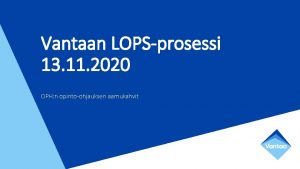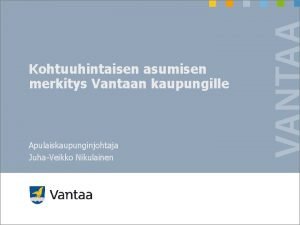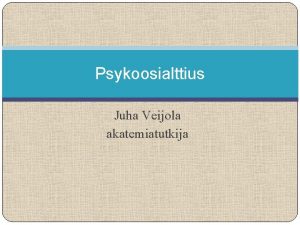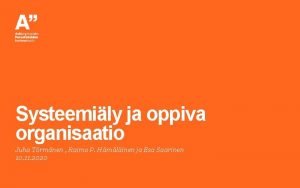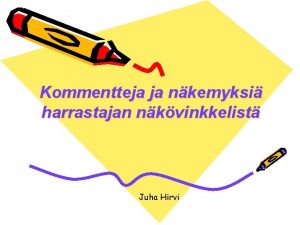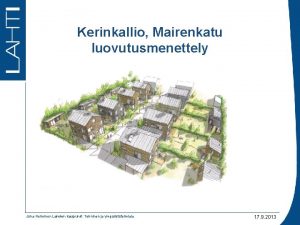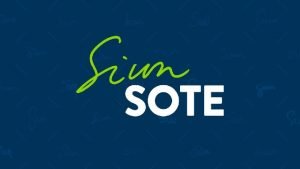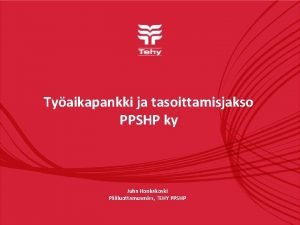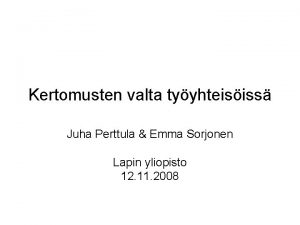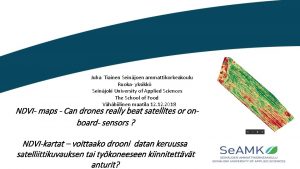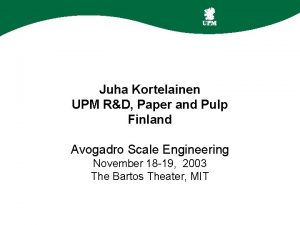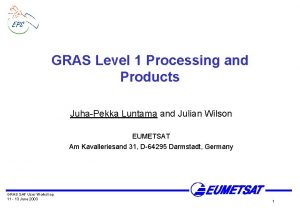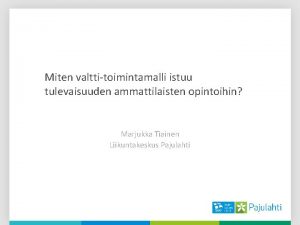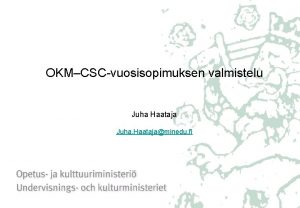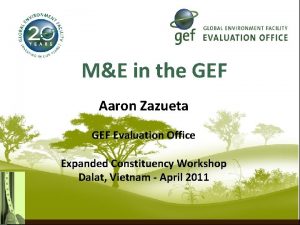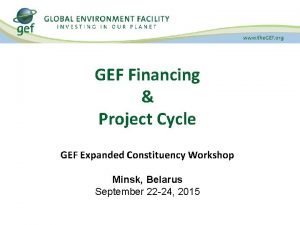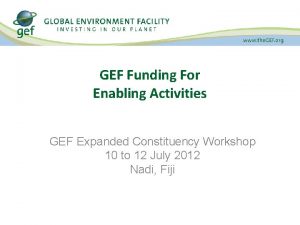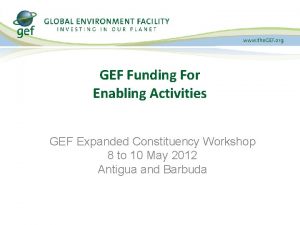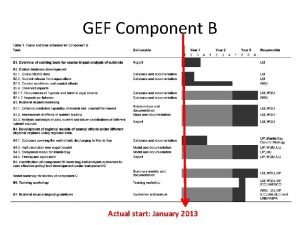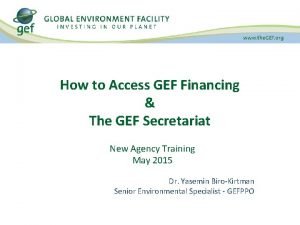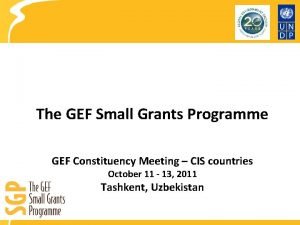EVALUATION IN THE GEF Juha Uitto Director GEF

























- Slides: 25

EVALUATION IN THE GEF Juha Uitto Director GEF Independent Evaluation Office May 2015

Monitoring <-> Evaluation Monitoring Evaluation Page 2

GEF M&E Policy • Defines the concepts, role, and use of monitoring and evaluation within the GEF • Defines the institutional framework and responsibilities. • Indicates the GEF minimum M&E requirements covering: • project design, • application of M&E at the project level, and • project evaluation. • Current M&E Policy Approved by GEF Council in November 2010 Page 3

M&E in the GEF: Objectives • Promote accountability for the achievement of GEF objectives through the assessment of results, effectiveness, processes, and performance of the partners involved in GEF activities. • Promote learning, feedback, and knowledge sharing on results and lessons learned among the GEF and its partners as a basis for decision making on policies, strategies, program management, programs, and projects; and to improve knowledge and performance. Page 4

Separate reporting lines for Monitoring (through Secretariat) and Evaluation (through Independent Evaluation Office) GEF Council Annual evaluation reports Overall Performance Study (to Assembly) Annual Work Program and Budget Agency evaluation units Annual Monitoring Report Evaluation Management Response Programming documents and indicators Results Based Management GEF Independent Evaluation Office Corporate evaluations Project and Program Independent evaluations Project and Program evaluations GEF Secretariat Project and Program Implementation Reports Agency Portfolio Reports Project documents with M&E plans Agency GEF coordination units Project and Program Implementation Reports Project and Program monitoring documentation Terminal evaluations GEF projects and programs Page 5

M&E Key Responsibilities in GEF Partner GEF Council GEF Independent Evaluation Office GEF Secretariat Key Roles and Responsibilities in M&E Policy-making Oversight Enabling environment for M&E Independent GEF evaluation Oversight of M&E Setting minimum requirements for evaluation GEF Results Based Management (monitoring and reporting) Review of GEF M&E requirements in project proposals Agency GEF operational units Monitoring of the Agency GEF portfolio Ensure M&E at the project level Agency evaluation units Project and/or corporate Agency evaluations Mainstreaming GEF into relevant Agency evaluation STAP Advice on scientific/technical matters in M&E Support to scientific and technical indicators Participating Countries Collaboration on M&E at portfolio and project levels Stakeholders Participation in monitoring activities and mechanisms Providing views and perceptions to evaluations Page 6

GEF Independent Evaluation Office • Mission – Enhance global environmental benefits through excellence, independence and partnership in monitoring and evaluation. • Principles – Impartiality – Professionalism – Transparency Created by decision of the May 2003 GEF Council. Added to the GEF Instrument in April 2014. Page 7

GEF IEO GEF-6 Work Program • The IEO will continue to provide feedback on the performance, results, and impacts of GEF support. • The GEF-6 Work Program will be organized around key issues derived from the Sixth Replenishment of the GEF Trust Fund and relevant to the GEF 2020 Strategy, such as: - The extent, mechanisms, and conditions by which GEF support has identified and delivered integrated solutions and multiple benefits. - The extent, mechanisms, and conditions by which GEF support has addressed drivers of environmental degradation. - The performance of the GEF, including issues related to the GEF 2020 Strategy core operational principles. Page 8

IEO Work Program for GEF-6 Page 9

Policy, Guidance and KM • Policy, Guidance, and Methodological Development: – – GEF M&E Policy Terminal Evaluation Guidelines Impact Evaluation Guidelines and Handbook Guidance on Evaluating Gender in GEF Programming • KM and Learning: – KM needs assessment. – Develop knowledge, learning, and communications strategy for GEF-6. – Review the GEF-6 KM strategy and work plan of the GEF Secretariat. Page 10

Office Initiatives • Climate-Eval Community of Practice • Participation in Conferences: – Evaluating Sustainable Development and NRM – 4 th International Conference on National Evaluation Capacities • Participation in GEF Meetings and Evaluation Networks: – Continue developing instructional and learning products to facilitate lessons learned from evaluations. – Develop new training materials to be distributed during ECWs in coordination with the GEF Country Support Program. – Maintain an active role in networks. Page 11

Thank you gefevaluation@thegef. org www. gefieo. org

The GEF M&E Policy and Terminal Evaluations Guidelines Aaron Zazueta Chief Evaluation Officer May, 2015

Overview 1. Minimum M& E requirements in the GEF M & E Policy 2. Terminal Evaluation Guidelines and Reviews 3. Management response and management action record A dynamic process. Full Agency M&E requirements are expected to be applied to GEF projects Page 14

M&E: Minimum Requirement 1 Design of M&E Plans Concrete and fully budgeted M&E plan by CEO endorsement for FSP and CEO approval for MSP. Project logical frameworks should align with GEF focal area results frameworks. M&E Plan should include: • SMART indicators • • • Specific measurable, achievable and attributable, relevant and realistic, (OPS 5 found this is critical) time-bound, trackable and targeted Baseline data for M&E by CEO endorsement Mid Term Reviews (where required or foreseen) and Terminal Evaluations included in plan Organizational set up and budget for M&E Page 15

M&E: Minimum Requirement 2 Implementation of M&E Plans Project/program monitoring and supervision will include execution of the M&E plan: • Use of SMART indicators for process and implementation • Use of SMART indicators for results • Baseline for the project is fully established and data are compiled to review progress • Organizational set up for M&E is operational and its budget is spent as planned Page 16

M&E: Minimum Requirement 3 Project/Program Evaluations: • • All full sized projects and programs will be evaluated at the end of implementation Evaluations should: Ø Ø Ø Be independent of project management or reviewed by GEF Agency evaluation unit Apply evaluation norms and standards of the GEF Agency Assess, as a minimum, outputs and outcomes, likelihood of sustainability, compliance with Minimum Requirements 1 & 2 Contain basic project data and lessons on the evaluation itself (including TORs) Should be sent to GEF IEO within 12 months of completion of project/program Guidelines for Terminal Evaluations Page 17

M&E: Minimum Requirement 4 Engagement of Operational Focal Points • • • M&E plans should include how OFPs will be engaged OFPs to be informed on M&E activities, including Mid Term Reviews and Terminal Evaluations, receiving drafts for comments and final reports OFPs invited to contribute to the management response (where applicable) GEF Agencies keep track of the application of this requirement in their GEF financed projects and programs OFPs can if they wish under take monitoring or evaluation of projects of country portfolio. Page 18

Terminal Evaluation Guidelines Purpose of terminal evaluations Ø Track performance of GEF portfolio Ø Provide feedback on GEF portfolio performance Ø Synthesize lessons that may help improve GEF functioning Page 19

Terminal Evaluation Guidelines Evaluation Criteria • Relevance. The extent to which the activity is suited to local and national development priorities and organizational policies, including changes over time • Effectiveness. The extent to which an objective has been achieved or how likely it is to be achieved • Efficiency. The extent to which results have been delivered with the least costly resources possible; also called cost effectiveness or efficacy • Results/Impact. The positive and negative, and foreseen and unforeseen, changes to and effects produced by a development intervention • Sustainability. The likely ability of an intervention to continue to deliver benefits for an extended period of time after completion. Projects need to be environmentally as well as financially and socially sustainable Page 20

Terminal Evaluation Guidelines Role of Agencies • • • Are carried out by Agencies at project completion Follow GEF IEO Terminal Evaluation Guidelines Done 6 months (±) of project completion Reviewed by Agency evaluation office ( WB, UNDP and UNEP) Submitted to the GEF IEO within 12 months of evaluation completion Page 21

Terminal Evaluation Reviews by the GEF IEO • GEF IEO reviews – Terminal evaluations not reviewed by the Agency Evaluation Offices – Random “spot checking” for the terminal evaluations reviewed by the Agency Evaluation Offices • • • Primary reviewers prepare draft reviews Peer reviewers provide feedback If required senior reviewers confirm the findings Draft reviews shared with Agencies Agency feedback incorporated Page 22

Terminal Evaluation Review • The Annual Performance Report (APR) presents aggregated ratings for the portfolio on: – Outcomes – Sustainability – Supervision – M&E – Progress to Impact • First presented in OPS 5, focus on GEF contributions to long term processes Page 23

Management Response and Follow up to Evaluations • A management response is required for all evaluations and performance reports presented to the GEF Council by the GEF IEO. It is coordinated by GEF CEO with inputs from other GEF stakeholders. • GEF Council takes into account both the evaluation and the management response when taken a decision. • GEF IEO reports on implementation of decisions annually trough Management Action Record (MAR). • IEO is available to provide information on management requests – Examples are: OPS 5 follow-up in RBM, Gender, KM Page 24

Thank you gefevaluation@thegef. org www. gefieo. org
 Tuula uitto
Tuula uitto Jenni korhonen
Jenni korhonen Ohjauksen aamukahvit
Ohjauksen aamukahvit Juha-veikko nikulainen kuollut
Juha-veikko nikulainen kuollut Psykoosialttius
Psykoosialttius Juha törmänen
Juha törmänen Juha hirvi
Juha hirvi Petri burmoi
Petri burmoi Juha matikainen
Juha matikainen Juha helminen lahti
Juha helminen lahti Heli sivonen
Heli sivonen Ylityölaskenta
Ylityölaskenta Juha perttula
Juha perttula Juha tiainen seinäjoki
Juha tiainen seinäjoki Aboatox
Aboatox Protideževna juha
Protideževna juha Raskaushepatoosi käynnistys
Raskaushepatoosi käynnistys Juha kortelainen
Juha kortelainen Juha-veikko nikulainen kuollut
Juha-veikko nikulainen kuollut Riblja juha od raže
Riblja juha od raže Juha sivonen
Juha sivonen Juha-pekka luntama
Juha-pekka luntama Petj
Petj Juha tiainen oulu
Juha tiainen oulu Juha vesanto
Juha vesanto Juha kostiainen yit
Juha kostiainen yit


